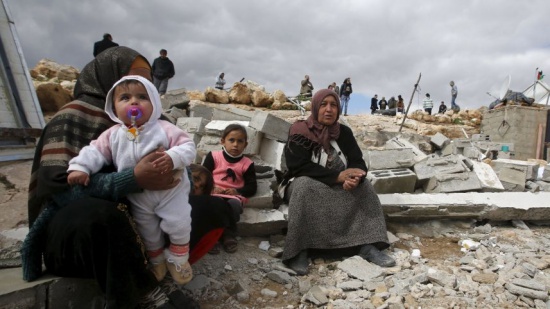Amira Hass, Haaretz: Israel Demolishes 23 Homes in Hebron Area to Make Way for IDF Training Zones
Latest development in multiyear battle leaves 60 children, 18 adults without dwellings. The Civil Administration in the West Bank on Tuesday demolished 23 homes and three outhouses in the southern Hebron hills villages of Jinba and Halawa. According to Israeli activists who reached Jinba by midday, shortly after the demolitions, 78 people had been living in the newly-built homes, including 60 children. On Monday morning, the State Prosecution and lawyers for the Association of Civil Rights in Israel (ACRI), as well as the villagers’ attorney Shlomo Lecker, announced that a bridging process started in October 2013 had failed. To the shocked surprise of residents and lawyers, within hours of informing the High Court of Justice of this development, Civil Administration officials arrived in these two villages and marked 40 dwellings for demolition. Less than 24 hours later they returned, accompanied by the army, and started destroying these structures. They also temporarily blocked a road leading to Jinba and confiscated vehicles and five solar panels. The bridging procedure, mediated by law professor Yitzhak Zamir, was suggested by the High Court of Justice. The two sides were sworn to secrecy during this process. However, the Society of St. Yves learned that during the procedure the army demanded that residents leave their homes for a few days each month so that military exercises could be held in the area. The residents objected, leading to the termination of the bridging process. Prior to the process, the state’s position was that residents of eight villages must move to the village of Yatta permanently, allowing them to cultivate their land and graze their sheep in the area at times when the army was not conducting exercises there, namely on weekends and Jewish holidays. Two more periods for cultivation and grazing would also be allowed during the year. Permanent residence in the villages would not be permitted. The residents of four other smaller villages were permitted to remain in the area, according to the state’s position in 2012. All the structures demolished on Tuesday were newly constructed dwellings, built in 2014 while the bridging process was in progress. They were made of concrete bricks, with corrugated tin roofs. Israel has not developed any construction plans for these villages, which have been there since the 19th century. Thus, any construction there is deemed illegal. However, natural growth and overcrowding have compelled residents to build even without permits. Fifteen of the demolished structures were in Jinba and the rest in Halawa. Many were built with financing provided by European and other foreign agencies. All 12 villages in the area developed naturally from settlements of cave-dwellers, who had originally inhabited the numerous caves in the area. These outlying areas of the adjacent town of Yatta started developing by the mid-19th century. In some of these villages, stone houses were already built before 1967. The residents always maintained social, family and economic ties with Yatta. The area around these villages was already declared a closed military zone back in the late 1970s. Only permanent residents were allowed to dwell there. In August and September 1999 most of the villagers received evacuation orders, based on the claim that they were “illegally residing within a live-fire zone.” The authorities informed them that they were deemed “intruders into a fire range.” On November 16, 1999 the army forcibly removed 700 residents, destroying houses and wells, as well as confiscating property. The residents were left without homes or any means of making a living.
|
hlavní článkynejčtenějšíPalestinci v noci ubránili vesnici před dalším nájezdem osadníků, které agresivně bránila armáda Izraelští extrémisté zaútočili na další dům ve vesnici Duma, kde bylo upáleno dítě 85 Percent of Palestinians killed by Israel were Extra-Judicially Executed |
Kontaktujte nás
Fax: +420 233 552 449



